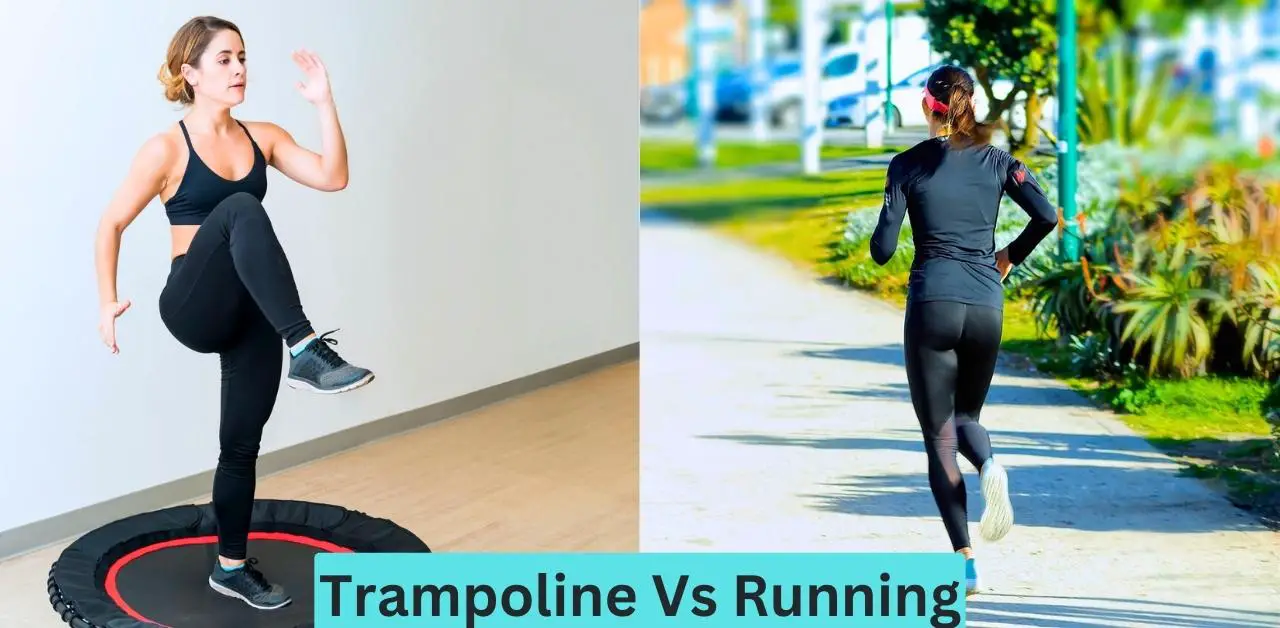Trampolines and running are popular physical activities that offer unique ways to exercise and promote overall health and fitness. Trampolines have a bouncy surface supported by a sturdy frame, allowing individuals to perform various jumps and movements.
Running, on the other hand, involves the act of propelling oneself forward at a faster pace than walking.
This article aims to compare and contrast trampolining and running as exercise options. By examining their characteristics, health benefits, considerations, and impact on different aspects of fitness, we can gain insights into which activity may be more suitable for individual preferences and goals.
This article will delve into the cardiovascular, muscular, joint-related, accessibility, and mental well-being aspects of trampolining and running, providing a comprehensive analysis of their respective merits.
Whether you’re looking for a fun and exhilarating workout or a more traditional form of exercise, this outline will serve as a guide to help you make an informed decision on whether trampolining or running aligns better with your fitness needs and personal preferences.
Trampoline vs. Running: Trampolining offers a thrilling bounce, engaging the entire body, while running provides a steady rhythm and challenging endurance. Both activities energize and elevate the spirit in unique ways.
Understanding Trampolining: An Overview

Trampolining is a highly popular and engaging form of exercise that involves jumping and performing various acrobatic movements on a trampoline. It provides a unique and enjoyable way to stay active and improve physical fitness.
we will explore the various aspects of trampolining as a form of exercise, including the description of trampoline structure and equipment, different types of trampolining, and the numerous health benefits it offers, such as cardiovascular benefits, muscle strengthening and toning, improved balance, coordination, and agility.
Description of Trampoline Structure and Equipment
Trampolines are typically made up of a strong, flexible fabric stretched tightly over a steel frame using coiled springs. The fabric, known as the trampoline bed or mat, is connected to the frame with springs that provide the necessary bounce.
The trampoline bed is usually supported by a sturdy metal frame that allows for stability and durability.
Trampoline equipment may also include safety features such as padding around the frame and springs to reduce the risk of injury. Safety nets are often installed around the trampoline to prevent users from falling off during vigorous bouncing or acrobatic movements.
Different Types of Trampolining
Trampolining can be enjoyed in various settings and for different purposes, catering to individuals of all ages and skill levels. Here are the different types of trampolining:
Recreational Trampolining:
Recreational trampolining refers to the casual and non-competitive use of trampolines for fun and physical activity. It is often enjoyed in backyards, indoor trampoline parks, or recreational centers.
Competitive Trampolining:
Competitive trampolining involves structured routines and performances on a trampoline, judged according to specific criteria. It is recognized as an Olympic sport and is practiced at both national and international levels.
Professional Trampolining:
Professional trampolining showcases highly skilled individuals who perform complex acrobatic routines on trampolines. These professionals often incorporate flips, twists, and other aerial maneuvers, pushing the boundaries of what can be achieved on a trampoline.
Health Benefits of Trampolining

Engaging in trampolining offers numerous health benefits that contribute to overall physical well-being. Let’s explore some of these benefits:
Cardiovascular Benefits:
Trampolining is an excellent cardiovascular exercise that pumps the heart and blood. Jumping on a trampoline increases heart rate and oxygen uptake, improving cardiovascular endurance over time.
Regular trampolining sessions can enhance overall cardiovascular fitness, which is crucial for a healthy heart and reduces the risk of cardiovascular diseases.
Muscle Strengthening and Toning:
Trampolining engages multiple muscle groups throughout the body. The repetitive bouncing motion activates the leg muscles, including the quadriceps, hamstrings, calves, and glutes, increasing muscle strength and toning.
Additionally, the core muscles are continuously engaged to maintain balance and stability, contributing to a stronger and more defined midsection.
Improved Balance, Coordination, and Agility:
Trampolining requires a high level of balance, coordination, and agility. Bouncing and performing acrobatic movements on a trampoline challenge the body’s ability to maintain equilibrium and control its movements in a dynamic environment.
Over time, regular trampolining practice can significantly improve balance, coordination, and overall body control.
Furthermore, trampolining helps to enhance spatial awareness and proprioception—the body’s ability to perceive its position and movement in space. This can positively impact other physical activities and sports requiring similar skills.
Running: An Overview
Running is a popular and accessible form of exercise that people of all ages and fitness levels have embraced. It offers numerous health benefits, including cardiovascular improvements, weight management, muscle and bone strengthening, as well as stress relief, and enhanced mental well-being.
we will delve into the different aspects of running as a form of exercise, including an overview of various running types, the equipment required for running, and the wide range of health benefits associated with this activity.
Explanation of Running as a Form of Exercise
Running is a highly popular and versatile form of exercise that involves the rhythmic movement of the body in a running gait. It can be performed both indoors on a treadmill and outdoors on various terrains such as roads, trails, or tracks.
Running offers numerous health benefits and is accessible to individuals of all ages and fitness levels. This section will explore the key aspects of running as a form of exercise.
Overview of Different Types of Running:
Running encompasses various forms, each with its own characteristics and benefits. These include:
Jogging: Jogging is a low-intensity form of running characterized by a steady and moderate pace. It is ideal for beginners or those seeking a less intense cardiovascular workout.
Sprinting: Sprinting involves short bursts of high-intensity running at maximum speed. It is excellent for improving speed, power, and explosive strength.
Long-Distance Running: Long-distance running involves covering extended distances, typically ranging from 5 kilometers to marathons or even ultra-marathons. It emphasizes endurance and requires proper training and preparation.
Equipment Needed for Running:
Running is a relatively equipment-friendly activity, but a few essentials can enhance comfort and safety. These include:
Running Shoes: Proper running shoes provide cushioning, support, and stability while minimizing the risk of injury. Choosing shoes that suit your foot type and running style is crucial.
Appropriate Clothing: Wear moisture-wicking and breathable clothing that allows for unrestricted movement. Consider weather conditions and dress accordingly to maintain comfort during your runs.
Health Benefits of Running

Running is an excellent form of exercise that offers numerous health benefits. Here are some of the key health benefits associated with regular running:
Cardiovascular Benefits:
Running is a highly effective cardiovascular exercise that strengthens the heart and improves overall cardiovascular fitness.
It elevates heart rate, increases oxygen intake, and promotes efficient blood circulation, reducing the risk of cardiovascular diseases such as heart attacks and strokes.
Weight Management and Calorie Burning:
Running is a fantastic calorie-burning exercise that aids in weight management. It helps create a calorie deficit, contributing to fat loss and weight maintenance. The intensity and duration of your runs influence the number of calories burned.
Strengthening of Leg Muscles and Bones:
Running primarily targets the muscles in the lower body, including the quadriceps, hamstrings, calves, and glutes. It strengthens these muscles, improving muscle tone, endurance, and overall lower body strength. Running also helps promote bone density, reducing the risk of osteoporosis and improving bone health.
Stress Relief and Mental Well-being:
Running has significant mental health benefits. It stimulates the release of endorphins, often called “feel-good” hormones, which can elevate mood and reduce stress and anxiety. Regular running can help improve sleep quality, boost self-confidence, and enhance overall mental well-being.
Trampoline vs Running: Comprehensive Comparison
Trampolining and running are two popular forms of exercise that offer unique benefits for cardiovascular health, muscle strengthening, toning, and improvements in balance, coordination, and agility.
we will compare the impact of trampolining and running on these aspects, considering heart rate elevation, endurance, overall cardiovascular fitness, targeted muscle groups, overall muscle development, and the effects on balance, coordination, and agility.
Impact on Cardiovascular Health
Both trampolining and running have a positive impact on cardiovascular health, but they differ in terms of the intensity and endurance required.
Comparison of Heart Rate Elevation and Endurance:
Trampolining: Trampolining can significantly elevate heart rate due to the continuous jumping and bouncing motions. The rapid movements and increased gravitational force experienced during trampolining provide an effective cardiovascular workout. However, heart rate elevation may vary based on the intensity and duration of the activity.
Running: Running, especially at a moderate to high intensity, elevates heart rate consistently. The sustained rhythmic movement of running engages large muscle groups and demands an increased oxygen supply, improving cardiovascular endurance.
Effectiveness in Improving Overall Cardiovascular Fitness:
Trampolining: Regular trampolining sessions can enhance cardiovascular fitness by improving heart and lung function. The repetitive jumping action increases oxygen uptake and strengthens the cardiovascular system, improving overall fitness levels.
Running: Running is renowned for its effectiveness in improving cardiovascular fitness. The continuous movement and elevated heart rate during running sessions challenge the cardiovascular system, increasing its efficiency and capacity over time.
Muscle Strengthening and Toning
Both trampolining and running contribute to muscle strengthening and toning, but they target different muscle groups and offer unique benefits.
Focus on Different Muscle Groups Targeted by Each Activity:
Trampolining: Trampolining primarily engages the leg muscles, including the quadriceps, hamstrings, calves, and glutes. The core muscles, including the abdominals and lower back, are constantly engaged to maintain balance and stability during jumps and landings.
Running: Running involves a full-body workout, engaging multiple muscle groups. While the primary focus is on the leg muscles, the upper body also plays a role in maintaining posture and arm movement. The quadriceps, hamstrings, calves, glutes, and abdominal and back muscles are all activated during running.
Comparison of Overall Muscle Development:
Trampolining: Trampolining can contribute to muscle strengthening and toning, particularly in the lower body. The repetitive jumping actions engage and challenge the leg muscles, promoting muscle development and endurance.
However, overall muscle development may focus more on specific areas than providing a comprehensive full-body workout.
Running: Running is known for its ability to provide overall muscle development. The repetitive impact and resistance experienced during running engage and strengthen the leg muscles, while the swinging motion of the arms also contributes to upper body toning. Regular running can improve muscle strength, endurance, and overall body composition.
Impact on Balance, Coordination, and Agility
Trampolining and running have distinct impacts on balance, coordination, and agility, with trampolining placing a greater emphasis on these aspects.
Assessment of Benefits in Improving These Aspects:
Trampolining: Trampolining requires a high level of balance, coordination, and agility. The dynamic and unpredictable nature of bouncing and performing acrobatic movements on a trampoline challenges the body’s ability to maintain equilibrium and control.
Regular trampolining can significantly improve these aspects, enhancing overall body awareness and coordination.
Running: While running does not directly target balance, coordination, and agility to the same extent as trampolining, it still contributes to these aspects. The repetitive movements and changes in terrain during running require constant adjustments in balance and coordination, promoting improvements in these areas over time.
Comparison of Impact on Motor Skills:
Trampolining: Trampolining involves complex motor skills, including jumping, flipping, and twisting, which require precise coordination and control. Regular trampolining practice can enhance motor skills, such as spatial awareness, timing, and proprioception.
Running: Running primarily focuses on the fundamental motor skill of locomotion. It improves stride length, gait efficiency, and rhythm. While not as varied in terms of motor skill demands as trampolining, running still contributes to overall motor coordination.
Jumping on the trampoline vs. running
According to a NASA study, jumping on a trampoline for just 10 minutes gives you the same benefits as running for 30 minutes. This means that exercising on a trampoline takes less time than running.
So, if you’re a busy parent who finds it hard to make time for exercise, you can quickly jump on a trampoline in your own backyard!
Rebounding vs. Running: The Ultimate Test Winner
In the ongoing duel between rebounding and running, a new contender emerges as the potential victor. While running has long reigned as the ultimate exercise, rebounding showcases remarkable prowess.
Like running, rebounding effectively torches calories and maintains an elevated heart rate throughout the workout. But the allure of rebounding lies in its added enjoyment and joint-friendly nature. This makes it an accessible choice for individuals of all fitness levels and backgrounds.
In our assessment, both workouts yielded results so close that crowning a superior calorie burner was a challenge. During her sessions, Sydney incinerated 218 calories through running and 234 calories via rebounding. Her average heart rate remained remarkably similar, leaving no definitive winner in this aspect.
However, remember that it’s not solely about uncovering the “perfect” workout with the highest calorie expenditure or enchanting benefits. Your unique circumstances should guide your decision.
Opt for low-impact rebounding if joint pain or injuries are concerns. Conversely, if a bustling household hinders outdoor runs, embrace the mini trampoline for a family-friendly exercise.
Equally crucial is pursuing enjoyment. Fitness should be a source of joy! It’s an opportunity to engage your body, nurture your mind, and practice self-care. It doesn’t have to revolve around intense sprints or burpees.
Explore diverse choices like dance, rock climbing, yoga, and, of course, our cherished pick grooving on a mini trampoline to rhythmic beats. In fitness, consistency reigns supreme, and that consistency stems from embracing a workout routine you genuinely relish.
Choosing the Right Activity
When it comes to staying active, the choice between trampoline exercise and running depends on your fitness goals, preferences, and physical considerations.
Trampolining offers low-impact cardio, improved coordination, and muscle toning, while running boosts endurance, burns calories, and enhances mood. Assess your objectives, health status, and accessibility to make the best decision.
Balance is key; consider integrating both activities for a well-rounded fitness routine that keeps you motivated and engaged. Remember, it’s about finding what works best for you and aligns with your long-term wellness journey.
FAQs:
Q1: Is trampolining a good form of exercise?
Absolutely! Trampolining provides a fun, low-impact workout that engages various muscle groups, improves cardiovascular health, and enhances coordination and balance. It is a great option for people seeking a less strenuous exercise alternative.
Q2: Is running a better workout than trampolining?
It depends on your fitness goals and personal preferences. Running is a high-impact activity that promotes endurance, strengthens bones, and burns calories efficiently. However, trampolining offers similar benefits while reducing the risk of joint and muscle injuries associated with running.
Q3: Does trampolining help with weight loss?
Yes, trampolining can aid in weight loss. It is an effective calorie-burning exercise that boosts metabolism and helps shed excess pounds. Trampolining may feel less intense than running but can still provide a significant calorie-burning workout.
Q4: Does running offer any advantages over trampolining?
Running has certain advantages, such as its accessibility and simplicity. You can run outdoors or on a treadmill, requiring minimal equipment. It is also a weight-bearing exercise, which helps strengthen bones and may have a greater impact on improving bone density than trampolining.
Q5: Are trampolines safe for all age groups?
People of various age groups can enjoy trampolines, but following safety guidelines is important. Always supervise children, use safety enclosures, and ensure the trampoline is in good condition. If you have specific health concerns or medical conditions, consult with a healthcare professional before using a trampoline.
Q6: Which activity is more enjoyable, trampolining or running?
The enjoyment of an activity is subjective and varies from person to person. Trampolining can be a thrilling and fun experience, especially for those who enjoy bouncing and performing aerial tricks.
Running, on the other hand, can be a meditative and stress-relieving activity for some individuals. It’s best to try both and see which activity you personally find more enjoyable.
Q7: Can trampolining help improve balance and coordination?
Yes, trampolining is known to enhance balance and coordination skills. The bouncing motion on a trampoline challenges your body to maintain stability, improving your proprioception and overall coordination. This can particularly benefit athletes and individuals looking to enhance their motor skills.
Conclusion:
In conclusion, both trampolining and running offer numerous health benefits and can be effective forms of exercise. Trampolining provides cardiovascular benefits by elevating heart rate and promoting endurance, making it a suitable option for improving overall cardiovascular fitness.
It also engages various muscle groups, particularly the core, legs, and glutes, leading to muscle strengthening and toning. Additionally, trampolining enhances balance, coordination, and agility, thereby improving motor skills.
On the other hand, running is a popular form of exercise that also offers significant cardiovascular benefits, promoting heart rate elevation and endurance. It is particularly effective for weight management and calorie burning, benefiting individuals aiming to lose weight.
Running primarily strengthens the leg muscles and bones, contributing to their overall development and strength. It also provides stress relief and positively impacts mental well-being.
When comparing trampolining and running, both activities have unique advantages. Trampolining engages a wider range of muscle groups, including the core, while running predominantly focuses on the legs.
Trampolining improves balance, coordination, and agility to a greater extent, making it beneficial for enhancing motor skills. However, running excels in weight management and calorie burning, offering effective cardiovascular benefits.
Ultimately, the choice between trampolining and running as a workout depends on personal preferences, fitness goals, and individual circumstances.
It is recommended to incorporate variety into exercise routines by combining both activities or exploring other forms of exercise to enjoy a well-rounded fitness regimen.
We hope this detailed guide helps you understand the differences between trampolining and running. If you have any questions, please feel free to leave a comment below!

